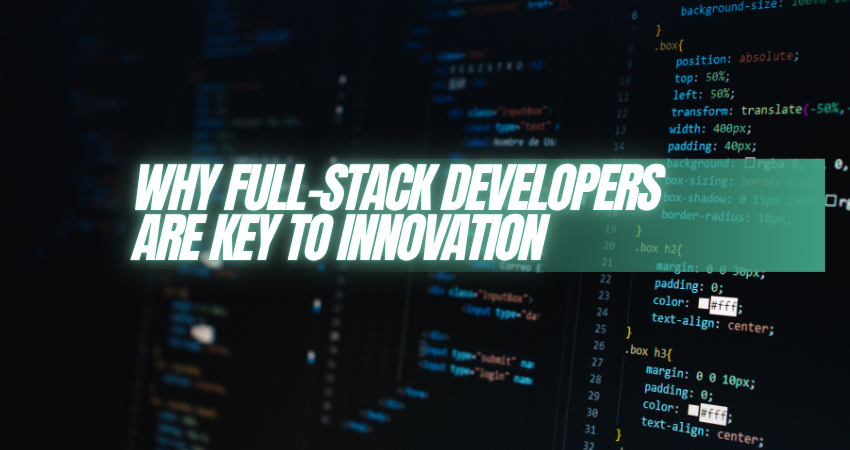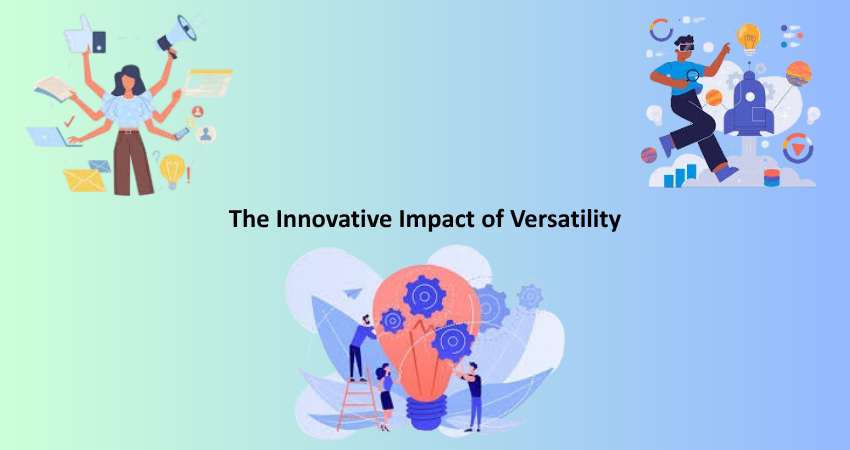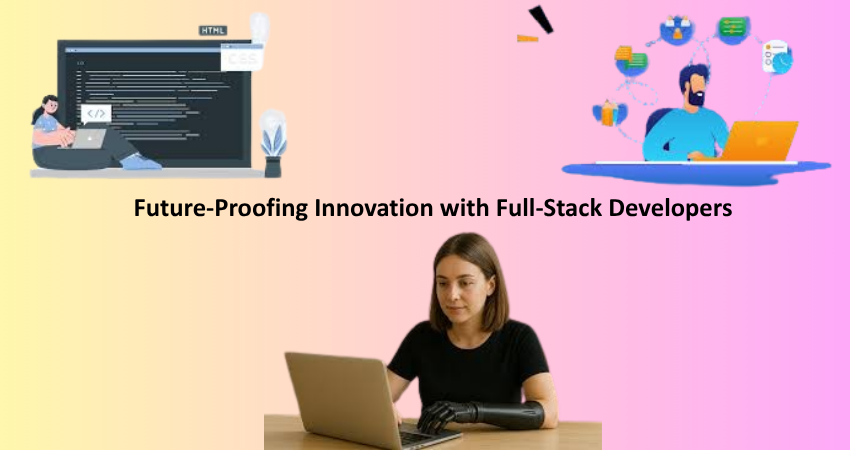
Introduction
In a world that has quickly transformed into a fast pace software development and digital transformation, an innovation is not just an entry word, but the survival strategy of all companies today. Having had an edge over their competitors, companies keep looking for process streamlining techniques, which lead to the making of robust and seamless end-user experiences. A full-stack developer is the most flexible and, now, increasingly inevitable person among these innovations. These professionals have an array of skills covering different fields in both front-end and back-end technologies. Furthermore, they have a complete understanding of the development lifecycle. Full-stack developers give one of the best prospects on bridging clashing aspects of development in software. They unify development into a lesser time frame and make changes very agilely according to changing business requirements.
The full-stack developer is very rarely a ‘one-stop’ vendor for any innovation. With their technical range and problem solving capacity, a full-stack developer could possibly help turn visionary ideas into scalable real products. They could go faster in the prototyping of concepts, troubleshooting issues across the entire tech stack, and work well with design and operations teams. The business world, intent on adapting to changing demands, has a full-stack developer at the center of change. These developers enable businesses to innovate faster and more effectively. As such, this article delves into the multi-faceted and multi-role nature of a full-stack developer, the benefits that the developer presents in innovation-driven environments, and how that unique capability is reshaping the future of technology.
Understanding the Role of Full-Stack Developers
Bridging the Front-End and Back-End Divide
Full-stack developers are such experts who are well versed with developing both front-end and back-end parts of software applications. Being a full-stack developer means a person can work on the user interface and understand what’s really going on in the background when a person trying to interact with the software application at those server logic and database interactions. Although front-end developers generally will be responsible for analysis and degree visuals and interactivity of applications using technologies such as HTML, CSS, and JavaScript, and frameworks like React or Vue.js, back-end developers work on the server-side operations – from building application programming interfaces, databases to server configuration – with the help of languages such as Node.js, Python, Ruby, or PHP.
Full-stack development means working on both sides; hence, the developer can maintain the integrity, efficiency, and optimization of the overall solution provided. An end-to-end understanding of the flow of data and interaction allows single-developer contributions to foresee potential problems, injections of improvements in the communication of front-end and back-end teams, and increased fluency in feature development. This practice will save time in development, provide better user experiences, and have functionality that flows smoothly. It further allows the developer to prototype an idea fast, iterate on feedback, and change direction when required—hallmarks of an innovative workflow.
Enhancing Communication and Collaboration
The most significant benefit full-stack developers get is improved communication and collaboration across interfaces between teams. In a conventional environment, front-end and back-end teams are locked in their own dismal cells, leading to miscommunication and misaligned expectations and slowing down the development cycles. Full-stack developers shatter the wall by being fluent in business and technology requirements at all levels of implementation. They act as intermediaries, bridging the gap between business goals and technical implementations.
Full-stack developers do not only serve as bridges between development teams but also extend the communication and visibility between these groups and with stakeholders from designers, project managers, and developers. Full-stack developers give much more comprehensive reports on how changes impact applications and round-feature up-from a smaller system perspective. It is about within high-velocity innovative environments built around rapid iteration with tight feedback loops. Those efficiencies communicate with tons. They eliminate bottlenecks, miscommunication, and create a more responsive dev process.
The Innovative Impact of Versatility

Accelerating Product Development Cycles
Innovation is usually all about speed-the ability to quickly shift from concept to execution while preserving everything in its quality. Full-stack developers help enable this speed by shortening dependency chains and streamlining workflows. They can deal with both front-end and back-end issues. This means that they can alone work on complete features or products instead of waiting for inputs from separate teams. This ability to ‘own’ a product feature from start to end accelerates the development lifecycle and reduces the amount of handing-off time normally associated with teams.
In addition, full-stack developers have expertise in developing minimum viable products (MVPs), which are important experiments for testing the possibility of an idea in real life without a huge investment. They can quickly prototype something, get the user feedback, and go on an iteration. This rapid prototyping is especially valuable in startups and innovation labs, where experimentation and learning are the main themes. The full-stack developer hat – wearing makes it possible for such a team member to be in requirement with agile environments requiring cross-functional roles and swift adaptability.
Innovating Through Problem Solving and Adaptability
Indeed, these full-stack developers are capable of adapting to such a highly discursive environment: attempts at solving problems creatively and flexibly-one of the key features of innovation. Their breadth of knowledge allows them to go beyond a specific technology or layer in the stack. When facing a challenge, they may think about it from all angles: performance optimization, UI/UX impact, database efficiency, and infrastructure scalability. It is through this holistic approach that problem-solving leads to more robust and innovative solutions that can scale.
The next feature that characterizes full-stack developers as innovators is their adaptability. Adaptability remains one of the highest requirement standards full stack developers should have because the rapidly evolving technology trends are followed by the corresponding changes in business requirements. Full-stack developers are found learning new frameworks, tools, and best practices to stay in touch with the innovation ideas of their organization. Their talent in discovering new tools and venturing into unfamiliar solutions while brow-raising pivot when necessary makes them very valued assets in organizations known for being always under the development process. They are often the pioneers of the change: new APIs integration, cloud native technology adoption, and switch to serverless environments.
Full-Stack Developers and Business Agility
Driving Cost Efficiency and Resource Optimization
The need to hire specialized developers for each part of the stack requires a lot of resources, and this is very difficult for startups or small teams that work on a limited budget. Hence, hiring full-stack developers is a more cost-efficient option as they cover a range of duties being relatively versatile. This versatility allows firms to achieve more with less resources; especially in innovation-oriented projects, this becomes crucial where funding could be tight and timelines aggressive. Thus, with full-stack developers, it becomes possible to functionally remain lean at the expense of larger, siloed teams, while still ensuring product quality and delivery velocity.
Full-stack developers save duplication in code and processes. Creating a general know-how makes them point inefficiencies that a siloed team would overlook. For example, optimizing the database query with the front-end rendering is good for performance. This holistic vision helps cut operational costs, which also translates into easily maintainable, more economically scalable software. This cost-efficient aspect comes to the aid of the business with the possibility of channeling these resources to further innovation or product development.
Enabling Rapid Pivoting and Strategic Experimentation
Innovation impinges on rapid change. Companies have to turn fast once ever-changing market conditions demand otherwise or when the first course of action does not pan out as the stakeholders had expected. Full-stack developers help maintain that agility by allowing for rapid experimentation and adjustments. Because they can work across the entire stack, they also get their changes implemented and tested fast, whether it is the complete front end, a new API, or back-end logic changing to satisfy fresh requirements.
Strategic experimentation supports innovation. Full-stack developers apply A/B testing, feature toggles, and phased rollouts with the least dependencies on other teams so they can capture feedback quickly and minimize iterations. This free movement allows organizations to explore new opportunities minimally, with organizational inertia weighing heavily on them. Whenever the idea matures into something tangible, full-stack developers can fast-track it to production; if it matures into vapourware, they can iterate or kill it just as rapidly, adding minimal overhead. This capability for rapid yet strategic experiments is what keeps enterprises ahead of the game in an ever-evolving mode driven by customer needs.
Future-Proofing Innovation with Full-Stack Developers

Integrating Emerging Technologies Seamlessly
With the emergence of new technologies such as artificial intelligence (AI), blockchain technology, augmented reality (AR), and the Internet of Things (IoT), the need for developers who can conceive and develop existing structures through these technologies will keep growing. Full-stack engineers already have a comprehensive understanding of how different parts of an application work in conjunction, making it easy for them to evaluate the impact that these technologies will have on front-end and back-end components and how they would mesh throughout the stack.
If you have AI-powered chatbots, it should have knowledge of the server-side algorithms that drive AI models and with client-side interactions that define the user experience. Full-stack developers can manage both to ensure a uniform function and optimal performance. Launching an integrated program also would allow for better understanding and management of the smooth transition towards adopting any new technology. Full-stack developers keep themselves ahead of cutting-edge technology trends and know how to relate them to fresh production applications, thus future-proofing innovations and securing competitive advantages.
Cultivating a Culture of Continuous Learning
Innovation thrives in perpetually prompt learning environments. Full-stack developers are naturally life-long learners. They must keep abreast of a range of tools, languages, and frameworks as part of their job. Therefore, their learning endeavors not only increase their own skill sets but also give rise to a culture of curiosity and experimentation in the teams they work in. SO full-stack-oriented organizations will see that engagement spreads to other teams, and knowledge-sharing appetite increases, thus creating demand for innovation.
On the other hand, full-stack developers not only gain their personal learning but also generally mentor and thus pass knowledge to other team members and, as said, encourage cross-functional skill development. UPSKILLING has been so much easier in these environments, as they become more resilient and versatile, targeting a wider range of challenges. The practice of encouraging full-stack thinking across the organization leads to democratized innovation and prevents reliance on a single silo. With embedded learning as a part of the company DNA, innovation can evolve into a sustainable and scalable endeavor.
Conclusion
Full-stack developers are truly much more than versatile programmers—these individuals are architects of innovation. That skill in navigating both front-end and back-end domains can help them create highly, scalable, and innovative solutions. Full-stack developers can be the bridge in communication gaps, speeding up development cycles, spearheading strategic experimentation, or catching the trends with cutting-edge technologies-all crucial roles in the contemporary world of software development. This demand for versatile professionals will only continue to rise as businesses move further into the realms of agility, flexibility, and rapid change.
Investments into such people would not just be a strategic investment in a project today, nor a pun aimed at the current set of projects, but rather a long-term investment into organizations to yield from future dividends. Beyond writing code, full-stack developers are part of team dynamics and a part of company culture and thus enable an organization towards continuous impact delivery experience of digital. In this new world, where innovation is the only survival key, these those who stand beside the champions of change at every layer within their technology stack, and bring visionary ideas into reality, are full-stack developers.